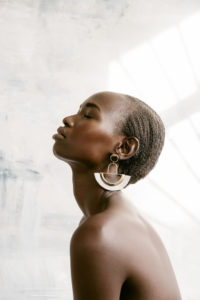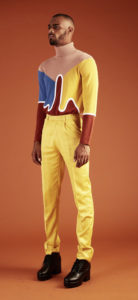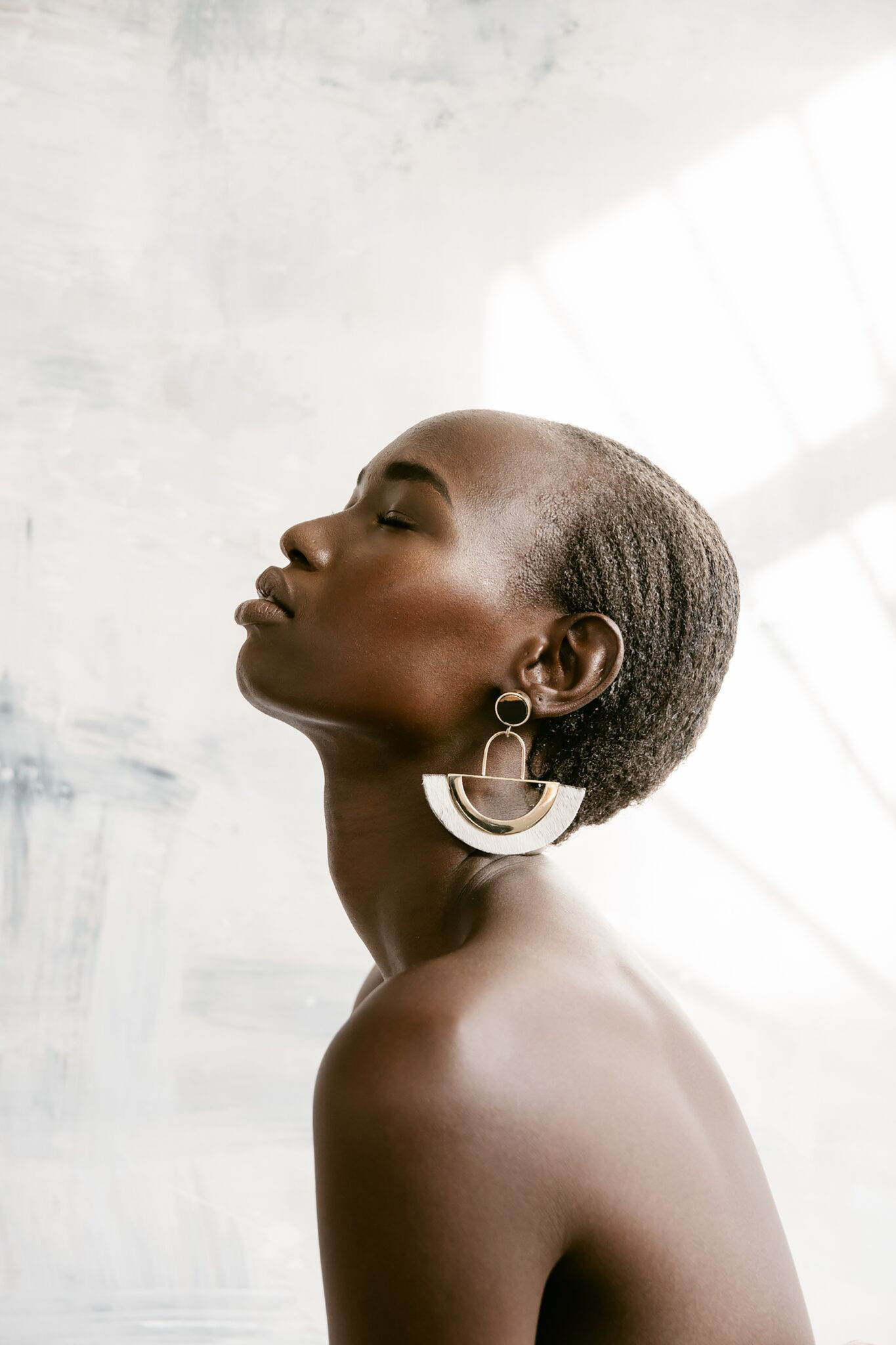
Jewellery by Kenyan label I AM I Photo: industrieafrica.com
There has been something of a cultural revolution around Africa as designers return to their roots
In October last year, renowned British fashion designer Stella McCartney launched her Spring 2018 collection at Paris Fashion Week. Her (mostly) white models sashayed down the catwalk swathed in gloriously colourful, sheeny Ankara fabric, the traditional cloth associated with West Africa.
While the applause from the glamorous attendees at the world’s premier fashion show was enthusiastic, McCartney was excoriated on BlackTwitter. The fashion icon, feted for designing the evening dress that Prince Harry’s bride, Meghan Markle, wore to her post-royal wedding party in May, was accused of cultural appropriation.
Nigerian writer and poet Amarachi Nwosu, using 140 characters, lambasted McCartney for using Ankara prints, “but using only one African model on her runway”. OkayAfrica, the digital media platform that focuses on African music, style and politics, accused the designer of “fashion colonialism”.
It kicked off the hoary old debate on cultural appropriation – who owns any particular cultural style and is acknowledgement of the cultural origins of a “borrowed” style necessary? BlackTwitter questioned whether it was appropriate that cloth traditionally worn by working class Africans was being used in designer wear that would sell for outrageous sums.
Shomoye George wrote: “I’m Nigerian! This is a joke! Feels like a slap as well! Loads doesn’t feel right here. Also feels exploitative. Where is the representation?” Cecile Victoire countered in the twittersphere with: “I’m very proud of all this because in African homes we wear Ankara to clean/cook. Seeing it on a runway… I love it.”
International designers Marc Jacobs, Givenchy, Eley Kishimoto, Jean Paul Gaultier, Diane Von Furstenberg, Dries van Noten, Kenzo and Paul Smith are just a few whose recent collections have included garments made out of Ankara cloth. Celebrities who’ve bought into this fashion trend include Beyoncé, Rihanna, Fergie and Kim Kardashian.
However there are real concerns, raised over decades, that dominant western cultures exploit the very specific ingredients of indigenous cultures without permission or acknowledgement. Designers have drawn inspiration from a host of ethnic traditions and ceremonial costumes since the beginning of fashion.
Renowned French coutourier Yves St Laurent’s 1967 African collection showcased the continent as exotic, ethnic, tribal, primitive; terms that many Africans – then and now – saw as pejorative and belittling.
The topic has even been debated by a UN agency, the World Intellectual Property Organisation. A question being asked is whether there should be laws to “prevent people from profiting from cultural appropriation”. Legislation, if implemented, would protect among other things, indigenous design, dance and medicines. South African designer and media commentator on fashion Craig Jacobs – whose clothing label, Fundudzi, dresses women around the world – is on the side of global fashion homogenisation.
“I am really not a loudhailer myself when it comes to complaining about the cultural appropriation of fashion,” he told Africa in Fact. “Do we hear US designers crying foul if we use denim, that most American of fabrics? Or when we draw inspiration from Japanese kimonos or cherry blossom motifs?” However, he adds that it is vital to acknowledge sources of inspiration, as John Galliano did when he famously celebrated the Maasai in a collection for Dior back in the 1990s.

From the autumn/winter 2018 collection by Malian label Xuly Bet Photo: industrieafrica.com
In fact, few of the fabrics that are now known to be distinctly African – textiles that are luminously waxed, brightly coloured or intricately patterned – originated in Africa. Scotland produced the bright tartan cloth we have come to associate with the Maasai. Senegal’s bazin fabric comes from Italy; Nigeria’s adire material, worn like a sarong, comes from Japan. South African ShweShwe, the traditional dress of Xhosa women, was first brought to the country by German immigrants in the late 1800s. So all of these fabrics, history teaches us, were culturally appropriated by Africans in Africa.
Meanwhile, there’s been something of a cultural revolution around Africa as creators of fashion return to their roots.
The Eastern Cape’s MaXhosa by Laduma Ngxokolo – one of South Africa’s fastest-growing fashion exports – has turned traditional Xhosa patterns into an international sensation. The very distinctive knitwear brand, with its bright colours and geometric patterns, has among its fans international superstars that include singers Beyoncé and Alicia Keyes. Putting paid to the idea that fashion has borders is Thai-born Capetonian Chu Suwannapha who, under the label Chulaap, has created a South African style that draws from South African cultural traditions.
Lesotho blankets, introduced by the Victorians and used practically for warmth in the icy mountain kingdom, have recently been incorporated into world fashion. They’ve been turned into handbags, coats and coat dresses, and the very unique Lesotho patterns (among them conical hats and red-hot poker flowers) have adorned everything from underwear to cushion covers. Last year, Louis Vuitton was accused of cultural appropriation after referencing the Basotho blanket in their menswear collection, Fundudzi’s Craig Jacobs points out.
However, the money-making business of fashion, and the exporting of African style to the rest of the world, is a topic that often trumps the cultural appropriation conversation. Fashion is big business. Indeed, West African economies have been revitalised by the growing global interest in Ankara. Nigeria’s textile industry, for example, has gained at least 25 new textile companies, after a decades long slump.
Countries such as Burkina Faso and Mali have strong textile heritages, including hand-woven cotton, indigo dyeing, and the Malian bogolan fabric, which is handmade from cotton and dyed with fermented mud. African design, which includes fashion and furniture and style, seems to have broken free from the old labels allotted by colonialism.
Social media, online purchasing websites, and the dissolution of borders have ensured that there are only global brands. One is as likely to find the same labels at Siam Paragon in Bangkok, Galeries Lafayette in Paris or Sandton City in Johannesburg. Jacobs attributes the new-found African confidence to changing patterns as African economies grow at exponential rates. He adds that online shopping has also made African brands easier to sell to an international audience.
The large and growing African diaspora naturally transports African fashion around the world, moving style and design imported from this continent into the mainstream. Los Angeles in the US hosts an annual Ankara Festival, where the purpose is to showcase the best of African culture through fashion, music, dance and food. It’s also a platform to introduce and expose young designers to international markets.

Menswear by South African designer Rich Mnisi Photo: industrieafrica.com
New York, London, Dublin, Toronto and Paris are among the world’s major fashion centres that host Africa fashion weeks, alongside their own haute couture shows. Social responsibility, empowerment of women, ethically sourced materials, humane treatment of garment workers… these are some of the sustainability issues being discussed as Africa finds new markets internationally.
Nigerian-born, London-based fashion designer Duro Olowu has been quoted as saying that Africa’s global fashion reach, combined with an awareness of social responsibility, “makes for a powerful statement”. Eco fashion has become part of a growing design philosophy and has at the centre of its goal the adoption of systems that are kind to both humans and the environment.
Helping to put African fashion on the map is Nigerian born, award-winning author Chimamanda Adichie who has taken to social media to launch her “Wear Nigerian” campaign. It’s designed to “sensitise and encourage people to buy from both upcoming, as well as established designers, to boost local trade and manufacturing”.
“In the past few weeks, I’ve bought more Nigerian brands than I ever have in the past,” Adichie wrote recently in a Facebook post. “I’ve discovered new names. I’ve been filled with admiration for the women and men running their businesses despite the many challenges they face. I’m particularly interested in ‘inward-looking’ brands, those for whom dressing Nigerian women is as important as other goals.” She uses her Instagram account to show off Nigerian outfits.
Stella McCartney, in fact, did acknowledge the origin of her Spring 2018 fabric on Instagram. New ethical standards are becoming more established in the fashion world globally. As regards Africa, these include initiatives aimed at meaningful social change as well as partnerships all along fashion’s supply chains that are economically acceptable to all. African fashion, whether in controversial or glowing terms, has made it onto the global scene. Africa is taking its rightful place in international couture.













